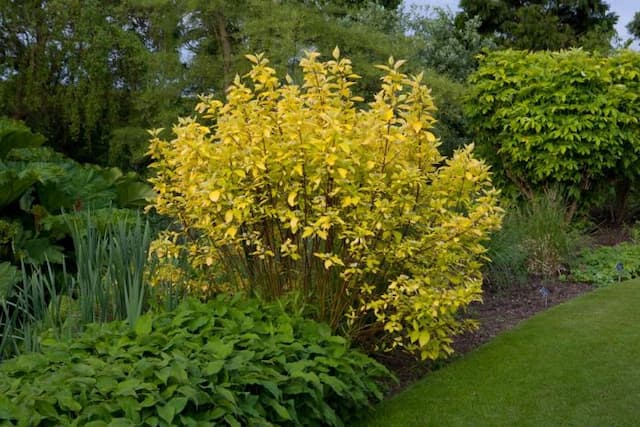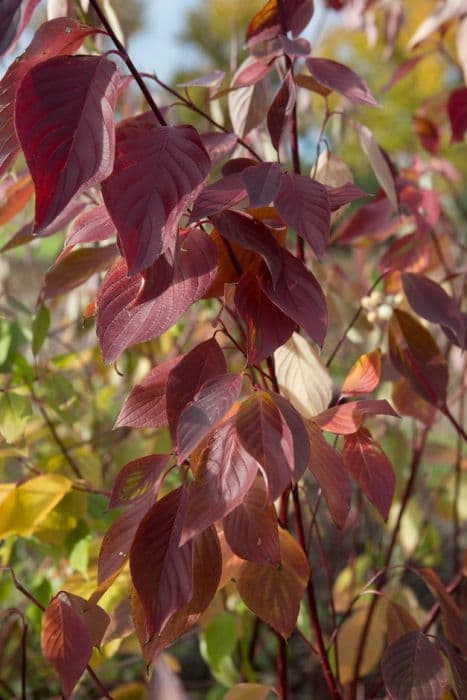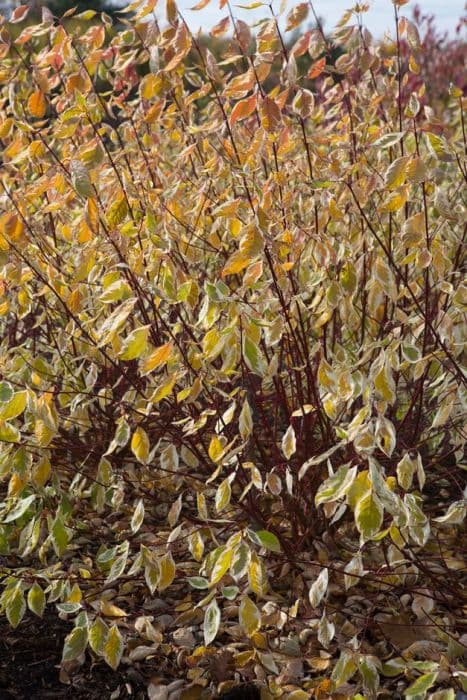Flowering Dogwood Cornus florida 'Sunset' (v)











ABOUT
The 'Sunset' variety of the dogwood is a stunning ornamental plant known for its distinctive foliage and brilliant flowering habit. This dogwood is adorned with pointed leaves that have a green-colored center surrounded by hues of yellow and cream, creating a variegated effect that is particularly eye-catching. Throughout the spring, the foliage provides a colorful backdrop for the flower display. The floral show is one of the plant's most striking features. In springtime, the dogwood produces large, four-petaled bracts that are typically perceived as flowers but are technically modified leaves surrounding the actual small, inconspicuous flowers. These bracts are commonly a creamy white or occasionally have a pinkish tinge, giving the appearance of a white blanket or cloud of blossoms that enliven the landscape. Come fall, the leaves of the dogwood transform into a range of fiery colors, featuring shades of red, orange, and purple, which create a warm tapestry in the garden as the temperatures drop. These autumn colors add a different dimension to the plant's attractiveness through the cooler season. Additionally, the dogwood produces red fruits that are particularly appealing to birds and wildlife. However, the fruits are not considered edible for humans. The berries, clustered in globe-shaped groups, stand out against the fall foliage and can persist into winter, adding to the plant's seasonal interest. The bark of the Sunset dogwood is another point of interest; with age, it develops a textured, visually intriguing pattern that gives the plant winter appeal even after the leaves have dropped. This bark texture provides an interesting visual contrast to the smoother bark commonly found in younger specimens or different plants. The combination of ornamental bracts, variegated leaves, transformation of fall colors, and attractive winter bark ensures that the Sunset dogwood offers interest across multiple seasons, making it a cherished specimen in many gardens for year-round beauty.
About this plant
 Names
NamesFamily
Cornaceae.
Synonyms
Flowering Dogwood, American Dogwood, Florida Dogwood, White Dogwood, Virginia Dogwood, Cornelian Tree, Boxwood, False Boxwood, St. Peter's Wood, Benthamia florida, Benthamidia florida.
Common names
Cornus florida f. rubra, Cynoxylon floridum.
 Toxicity
ToxicityTo humans
The common name for Cornus florida 'Sunset' (v) is flowering dogwood. This plant is not commonly known to be toxic to humans; however, parts of the plant, especially the fruit, can cause mild symptoms if ingested in large amounts. Symptoms might include stomach upset, nausea, vomiting, and diarrhea. It is generally advised to avoid ingestion of plant parts.
To pets
The common name for Cornus florida 'Sunset' (v) is flowering dogwood. This plant is considered to be of low toxicity to pets, such as dogs and cats. In some cases, consumption of large amounts of the fruit may cause mild gastrointestinal distress, including symptoms like vomiting or diarrhea. It's recommended to discourage pets from eating any parts of the plant.
 Characteristics
CharacteristicsLife cycle
Perennials
Foliage type
Deciduous
Color of leaves
Varied
Flower color
White
Height
15-30 feet (4.6-9.1 meters)
Spread
20-25 feet (6-7.6 meters)
Plant type
Tree
Hardiness zones
5-9
Native area
North America
Benefits
 General Benefits
General Benefits- Ornamental Value: The Cornus florida 'Sunset' is prized for its striking variegated foliage and beautiful, showy spring flowers which add aesthetic appeal to any landscape.
- Wildlife Attraction: Its berries provide a food source for birds and other wildlife, enhancing biodiversity.
- Shade Provision: As a deciduous tree, it offers shade in the summer, which can improve comfort in outdoor spaces and potentially reduce cooling costs.
- Seasonal Interest: This plant offers year-round interest through changing leaf colors in the fall and a notable winter silhouette.
- Erosion Control: The root system can help stabilize soil and prevent erosion on slopes or in areas prone to heavy rain.
- Adaptability: It can adapt to a variety of soil conditions, though it prefers well-drained, acidic soils.
 Medical Properties
Medical PropertiesThis plant is not used for medical purposes.
 Air-purifying Qualities
Air-purifying QualitiesThis plant is not specifically known for air purifying qualities.
 Other Uses
Other Uses```html
- Natural Dye: The bark and roots of Dogwood can be used to make natural dyes for textiles, providing shades of red and brown.
- Tool Handles: Hardwood from Dogwood can be crafted into durable tool handles for hammers and garden tools due to its strength and shock resistance.
- Wildlife Habitat: Dogwood trees provide essential shelter and nesting sites for birds and other wildlife within their dense branches.
- Instrument Making: Dogwood's fine-grained wood is sometimes utilized in creating musical instruments, like flutes or pipes, for its acoustic properties.
- Wood Carving: The wood's tight grain makes it suitable for detailed carving, and it is sometimes used for small sculptures or intricate woodworking projects.
- Water Treatment: Dogwood roots and bark contain tannins that can be used in natural water purification processes to help bind and remove sediment.
- Erosion Control: The spreading roots of the Dogwood help stabilize soil, making them useful for planting in areas prone to erosion.
- Photography: The striking springtime blossoms of Dogwood can be used as subjects for botanical photography and artistic inspiration.
- Educational Resource: Dogwood trees can be used in educational settings to teach about plant biology, pollination, and the changing seasons.
- Winter Interest: With its bright red berries and textured bark, Dogwood offers visual interest in winter landscapes when most other plants are dormant.
Interesting Facts
 Feng Shui
Feng ShuiThe Flowering Dogwood is not used in Feng Shui practice.
 Zodiac Sign Compitability
Zodiac Sign CompitabilityThe Flowering Dogwood is not used in astrology practice.
 Plant Symbolism
Plant Symbolism- Beauty: Commonly known as the Flowering Dogwood, Cornus florida 'Sunset' is celebrated for its beautiful pink or white spring blossoms, symbolizing beauty in nature.
- Resilience: The Flowering Dogwood is known for its ability to withstand various growing conditions, representing strength and endurance.
- Rebirth: With its vigorous bloom in the spring, the Flowering Dogwood signifies renewal and the beginning of new life, akin to the season it flourishes in.
- Purity: The crisp, white flowers of the standard Flowering Dogwood can symbolize purity and innocence.
- Christian symbolism: In Christian traditions, the Flowering Dogwood is associated with the crucifixion of Jesus, making it represent faith, sacrifice, and the resurrection.
 Water
WaterFor the Flowering Dogwood, typically it should be watered thoroughly once a week, making sure the water penetrates the soil to a depth of at least 6 inches. During the hot, dry summer months, watering frequency may increase to twice a week. It's important to provide about 1 to 1.5 gallons of water each time you water an established tree, adjusting for rainfall to ensure the soil remains moist but not waterlogged. For newly planted saplings, water every 2 to 3 days to help establish roots. Overwatering can be as detrimental as under-watering, so it’s essential to monitor the soil moisture regularly.
 Light
LightThe Flowering Dogwood thrives best in partial shade to full sun, which constitutes about four to six hours of direct sunlight per day. Ideally, planting it in a spot that receives morning sun and afternoon shade can help protect the plant from scorching during the hottest part of the day. Ensure the selected location is away from intense, reflected heat to avoid leaf burn.
 Temperature
TemperatureThe Flowering Dogwood prefers temperate conditions and will thrive in an environment where temperatures range between 65°F and 75°F. This plant can survive minimum temperatures down to approximately 25°F and can tolerate the summer heat up to a maximum of around 85°F. Avoid placing the Flowering Dogwood in areas where temperatures drop below freezing for extended periods or rise above the comfortable temperate range for too long.
 Pruning
PruningPruning the Flowering Dogwood is important to maintain its shape, remove dead or diseased branches, and promote strong structure. It is best to prune in late winter or early spring before new growth begins. Typically, pruning every 2 to 3 years is sufficient, but annual removal of damaged or diseased wood is recommended. The correct method involves making clean cuts at a 45-degree angle to avoid damaging the bark and leaving enough room for the tree to heal.
 Cleaning
CleaningAs needed
 Soil
SoilThe Flowering Dogwood 'Sunset' prefers well-drained, rich loamy soil with a pH of 5.5 to 6.5. A mix of garden soil, compost, and a small amount of sand or perlite to improve drainage makes the best soil mix. Mulching is beneficial to maintain soil moisture.
 Repotting
RepottingFlowering Dogwoods typically do not need repotting as they are outdoor plants. Planting in the ground rather than pots is recommended.
 Humidity & Misting
Humidity & MistingFlowering Dogwood 'Sunset' adapts to outdoor humidity levels well but prefers a moderate humidity environment when grown outdoors, not too dry.
 Suitable locations
Suitable locationsIndoor
Provide bright light, no direct sun.
Outdoor
Plant in partial shade, sheltered from wind.
Hardiness zone
5-9 USDA
 Life cycle
Life cycleCornus florida 'Sunset' (v), also known as Flowering Dogwood, begins its life cycle as a seed that, once germinated, develops into a seedling. With sufficient light, water, and soil nutrients, the seedling transitions into a young sapling marked by primary growth and the formation of a single main stem. As the sapling matures, it undergoes secondary growth, thickening its trunk, broadening its crown, and developing a more complex root system. The adult stage is characterized by its production of vibrant flowers in the spring, followed by the formation of berries that attract wildlife and aid in seed dispersal. The tree continues to mature and can live for numerous years, experiencing cycles of growth, flowering, and dormancy. Eventually, as it reaches the end of its life span, it declines in health, which may be manifested through lessened foliage, dead branches, and susceptibility to disease and pests, leading to its eventual death.
 Propogation
PropogationPropogation time
Spring-Early Summer
Propogation: The Cornus florida 'Sunset', commonly known as the Flowering Dogwood, is often propagated through the method of semi-hardwood cuttings. This involves taking cuttings from the current season's growth that has begun to mature but is not yet fully hard. The ideal time to take these cuttings is in the late summer to early fall when the plant's growth begins to slow down. For successful propagation, cuttings should be about 4 to 6 inches long, with several sets of leaves. The bottom set of leaves is removed, and the cut end is often treated with a rooting hormone to encourage root development. The prepared cutting is then planted in a well-draining soil mix and kept in a humid environment until roots have established, which can take several weeks to a few months.

![Dogwood [Baton Rouge]](/_next/image?url=https%3A%2F%2Fplants-admin.emdemapps.com%2Fimages%2Fplants%2F%2Fimages%2F604b59cf0fefd.png&w=640&q=75)


![Dogwood [Ivory Halo]](/_next/image?url=https%3A%2F%2Fplants-admin.emdemapps.com%2Fimages%2Fplants%2F%2Fimages%2F604b535cbcb9a.png&w=640&q=75)




